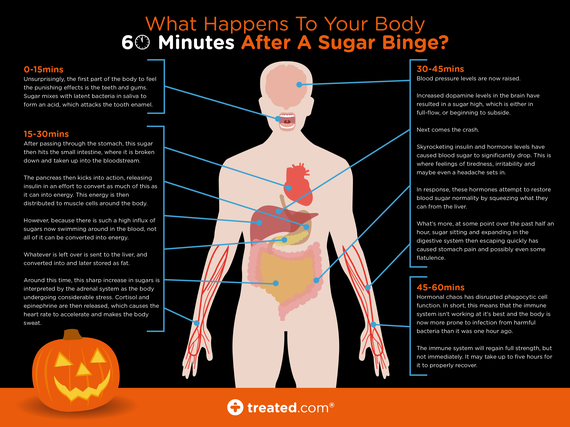Halloween is one of the few occasions throughout the year where it's considered socially acceptable to overindulge on chocolate and sweets; for kids and parents alike.
But social tradition doesn't make your body any better at coping with such a high and fast influx of sugars.
Far from it; consuming more than your recommended daily intake of sugar (90g total sugars) in one sitting gives your system quite a punishing, and a considerable amount of work to do. And, as we'll explore in the timeline below, that's just during the first hour.
Here's what actually takes place in your body in the 60 minutes following a sugar binge:

0 - 15 minutes
In the mouth, sugar combines with bacteria to produce an acid which attacks tooth enamel.
15 - 30 minutes
Once the sugar passes from the stomach into the small intestine, it is broken into glucose and sucrose, and soaked up into the bloodstream.
The pancreas then pumps out insulin to try and mop up this influx and convert it into energy.
The body attempts to send this energy to the muscles, but there will ultimately be too much sugar to deal with. What isn't converted into energy, the liver turns into stored fat.
Meanwhile, this massive influx of sugar and energy convinces the body that it is under a huge amount of stress and, as a result, sets off an adrenal reaction. Cortisol and epinephrine are released into the system, which causes the heart rate to increase, and may even trigger some sweating.
30 - 45 minutes
Blood pressure levels are elevated. Dopamine levels in the brain are raised too and a sugar high is probably in full swing.
However, the comedown is in the post.
Once the body has managed to flush out all the sugar it can from the bloodstream, what ensues next is a sugar crash. This is when glucose levels drop drastically causing lethargy and fatigue.
While this is going on, the sugar drop may well instigate a 'sugar hangover' in the form of a headache. It may also induce loss of concentration and feelings of irritability.
Stress-reactive hormones then attempt to squeeze what sugar they can out of the liver, to try and achieve stability.
45 minutes onwards
Fluctuating hormone levels have a knock-on effect on phagocyte function, temporarily rendering the immune system less able to protect against infection.
How much sugar is a safe amount?
There's nothing wrong with enjoying an occasional treat. But it's important to realise that eating too much sugar too fast presents your body with a monumental workload.
The recommended daily intake of total sugars (sugars from all food) for adults is 90g, as typically noted on food packaging. But this doesn't mean you can safely eat three 51g Mars Bars (containing a total of 91.5g of sugar) in one day and still be within negligible distance of the threshold.
Chocolate, sweets, sugary snacks and fizzy drinks contain added sugar, and the NHS advises that no more than five per cent of your total daily calorie intake should come from foods of this type.
So really, for those aged 11 and over, the upper limit of sugar intake from products with added sugar is somewhere closer to 30g per day.
To give some perspective, a bag of Skittles contains almost 50g. A can of Coke contains around 36g.
What's more, the sugar you eat needs to be spread out as evenly as you can throughout the day.
Your body requires sugar to be able to work properly, and it's essential for energy conversion and the function of muscles. But remember that processing lots of it at once is quite a task. The more gradual your intake, the better your body will be able to deal with it.
Halloween is a great family occasion, but try to educate your children on eating sensible amounts of sugar early on. The more they view over-indulging as acceptable, the more likely they are to do it when you aren't around, as well as in later life.